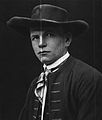Rossberg costume
The Roßberg costume (Polish: Strój rozbarski ) is a very common costume in Upper Silesia . It is named after Roßberg , who is considered the cradle of the traditional costume movement.
Costumes
Roßberg was one of the few places in Silesia where traditional costumes were still very common in the 20th century. The place also had costumes for men, which rarely happened in Silesia. The costume of the Roßberg farmers was also characterized by the use of noble materials, which made them very valuable. Some components of the costume that the wreaths (bride and groom couples) wore were even owned by the community and were borrowed for special occasions. In addition, the Roßberg costumes had a lot of band jewelry.
A striking feature of the women's costume is the white, large and wide lace cap that hangs down like a veil. It was worn alternately with a purple headscarf. A white blouse with short sleeves was part of the women's costume. And finally, a black jacket with long sleeves was put on. A dark, patterned cloth (mostly of oriental origin) was also wrapped over the jacket. Two large, broad, light-colored ribbons with a floral pattern hung down from the shoulders over the jacket or the scarf and reached down to the skirt.
The girls wore eye-catching headdresses at weddings as bridesmaids and at festive processions. The headgear known as maiden hoods consisted of a stuck fabric ribbon with a flower pattern, on which a high myrtle crown was placed. Two straps hanging down were attached to the back of the hood. A red chain (made of real pearls, coral or amber) with a cross was worn around the neck, which was usually placed in three rows around the neck. A dark skirt was worn around the waist, usually reaching to the knees, and a light silk apron was tied over it, which usually also had a flower pattern. A waist band was tied around the apron and tied into a bow. On the upper part of the body, over a white blouse with short puffy sleeves, a felt bodice was worn, which was mostly red and had gold buttons, at shoulder height and in the area of the neckline was a light fabric ribbon with a floral pattern. Finally, a bright ribbon was wrapped in a bow and attached to the neck. In everyday life, a white cloth was also folded over the upper body, which covered the entire bodice from the front.
The blue jackets or blue vests and yellow deerskin trousers are characteristic of the men's costumes. The vest reached over the hips. The jackets and vests had a red border and gold-colored buttons. In addition, black high boots reaching to the knees were worn. A black hat was worn as headgear, which could also have a gold ribbon around the crown of the hat. The brim of the hat was very wide. Polecat fur hats were also worn in winter. A colorful scarf was attached to the neck, for example in red and gold.
Boys wore the same costume, but as bridesmaids at weddings they also wore a bouquet of flowers on their jacket and a dark ribbon with a flower pattern underneath the bouquet.
Roßberger costume in art
The Roßberg farmers and their costume also became a frequent motif in art. The artist Walter Schölei-Breslau (* 1891), who was born in Lüben, created two oil paintings with the titles “Farmer from Roßberg near Beuthen O / S” and “Farmer from Roßberg near Beuthen O / S”. The painter Richard Knötel (1857–1914) and the painter Hedwig Grabowski also painted Rossberger women in traditional costumes in their works. The artist Georg Kinner from Beuthen also painted paintings of a farmer and a farmer's wife. One of the earliest color photos was taken in Roßberg in 1920 , showing a peasant family in traditional costume. This photo was exhibited in 2007 in the exhibition “100 Years of Color - Early Photographs” in the City Gallery Erlangen. Further black and white photographs were in the possession of the Oberschlesisches Museum in Gleiwitz. In a series of stamps issued by the German Reich in 1935 for the Winter Relief Organization with depictions of German folk costumes, the Roßberg costume was shown as a representative of the Silesia region. In the background you can see the Annaberg with the monastery.
In 1934 a re-enactment of a Roßberg farmer's wedding in the radio station Gleiwitz was broadcast by the Silesian radio station . Film recordings were also made.
Bridesmaids in costume, photo by Max Glauer
Web links
Individual evidence
- ↑ Monographs of German Cities. Vol. 15, Beuthen O / S .; 1925
- ↑ Städtische Galerie Erlangen: 100 Years of Color - Early Photographs ( Memento of the original from October 4, 2015 in the Internet Archive ) Info: The archive link has been inserted automatically and has not yet been checked. Please check the original and archive link according to the instructions and then remove this notice.
- ↑ Upper Silesia in Pictures, No. 6, 1934







